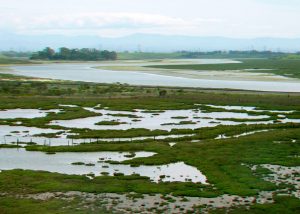California Department of Fish and Wildlife Awards $3 Million Grant for Carbon Sequestration
Watsonville, CA – The California Department of Fish and Wildlife (CDFW) has 
In central California, the greatest potential for trapping and storing “blue carbon” — carbon dioxide (CO2) captured by plants and soils in coastal ecosystems — is at Elkhorn Slough located in the central Monterey Bay area. The slough features one of the most extensive salt marsh in California outside San Francisco Bay, and researchers have associated its natural marshes with high rates of carbon sequestration.
Salt marshes are particularly important as “carbon sinks,” (natural systems that can absorb and store carbon) because the carbon they capture is buried indefinitely. As plants trap sediment, it builds, increasing the layers of marsh and the carbon is retained in the expanding root system of the plants.
Since 1870, nearly 50% of Elkhorn Slough’s historic tidal marshes have been diked and drained to create pasture and farmland. Once drained, the ground of these former marshes subsided, dropping from one to six feet below historic elevations. Because these areas are now situated too low to support healthy salt marsh, the estuary is no longer serving its full capacity as a carbon sink.
In addition to the groundbreaking research on marshes and carbon storage, the Tidal Marsh Restoration Project will restore approximately 50 acres of salt marsh by adding sediment to raise base elevations to levels that will support tidal marsh. This will increase salt marsh acreage, and the carbon storage potential of the estuary and provide an opportunity to carefully measure the benefits to the system.
The State Coastal Conservancy, California Department of Water Resources Integrated Water Resource Management Program and United States Fish and Wildlife Service National Coastal Wetlands Conservation Program have also provided supporting funding and guidance for this project.
The Tidal Wetland Project is a collaborative effort to develop and implement strategies to conserve and restore estuarine habitats in the Elkhorn Slough watershed. Led by the Reserve, the project has been planned with input from more than 100 coastal resource managers, scientific experts, representatives from key regulatory and jurisdictional entities, leaders of conservation organizations, and community members.
The project site is owned and managed by the California Department of Fish and Wildlife in partnership with the National Oceanic and Atmospheric Administration (NOAA).
For more information on the Tidal Wetland Project visit www.elkhornslough.org/tidalwetlandproject.
“This award is the result of a tremendous collaborative effort with the hard work of many people over many years. We are excited about the potential to both restore critical habitats, and to counter the impacts of CO2 on our environment,” says Dave Feliz, Fish and Wildlife
Biologist and Manager of the Elkhorn Slough National Estuarine Research Reserve.
In addition to supporting this major restoration project, the grant will fund exciting new research documenting the exact blue carbon benefits of the project. “There have been many ‘back-of-the-envelope’ calculations of potential benefits to marsh restoration,” says ESNERR Research Coordinator Dr. Kerstin Wasson. “But now we will find out firsthand what the real benefits are, by measuring carbon storage at the site before and after restoration. What we learn from this project will help make future coastal marsh recovery activities more successful and sustainable.”
The grant provides $2,996,768 to the Elkhorn Slough Foundation for this work on the Elkhorn Slough National Estuarine Research Reserve. The funding has been generated through the Greenhouse Gas Cap-and-Trade program, established by the state.
The Elkhorn Slough Foundation (ESF) is a community-supported non-profit land trust whose mission is to conserve and restore the Elkhorn Slough and its watershed. ESF protects 4,000 acres of rare habitat including oak woodlands, maritime chaparral, and wetlands. Since 1982, ESF has been the non-profit partner of the Elkhorn Slough National Estuarine Research Reserve (ESNERR), one of 28 research reserves around the nation, funded through NOAA.
The CDFW manages the 1,700-acre Reserve, which features rare habitat while providing five miles of public trails, education, research, and volunteer programs. An active volunteer corps of nearly 100 community members supports the work of the Reserve. The Elkhorn Slough National Estuarine Research Reserve (ESNERR) is one of 28 reserves established nationwide to support long-term research, water-quality monitoring, environmental education, and coastal stewardship. For more information on Elkhorn Slough Foundation and the Reserve, visit www.elkhornslough.org.
Elkhorn Slough, located in the central Monterey Bay area encompasses a wide variety of habitats — including oak woodlands, maritime chaparral, coastal prairie, and the largest tract of tidal salt marsh in California south of San Francisco Bay — that support an incredible diversity of life. Estuaries like Elkhorn Slough are among the most threatened ecosystems in California, harboring disproportionate numbers of rare, threatened, and endangered species, including two-dozen listed species using the slough. Upland and tidal habitats in and around the slough support 340 species of birds, 550 marine invertebrate species, 100 fish species as well as resident sea lions, harbor seals and the highest concentration of endangered Southern sea otters on the west coast.
For more information, visit www.elkhornslough.org.